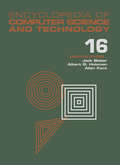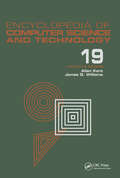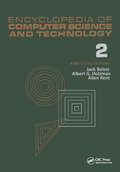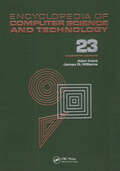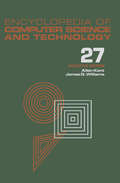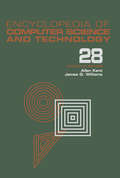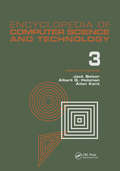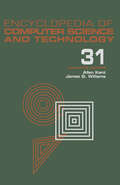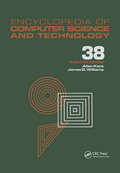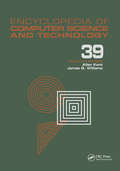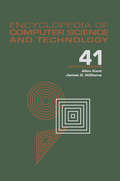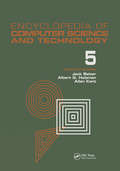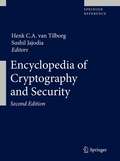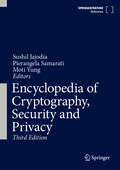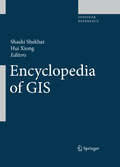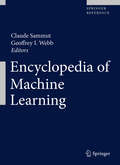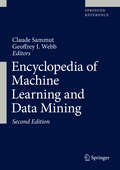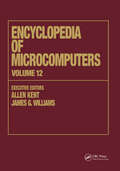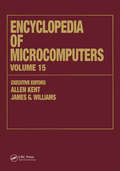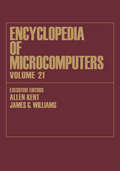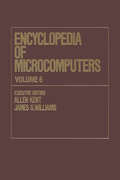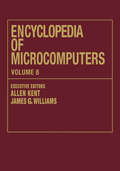- Table View
- List View
Encyclopedia of Computer Science and Technology: Volume 16 - Index (Computer Science And Technology Encyclopedia Ser.)
by Jack Belzer""This comprehensive reference work provides immediate, fingertip access to state-of-the-art technology in nearly 700 self-contained articles written by over 900 international authorities. Each article in the Encyclopedia features current developments and trends in computers, software, vendors, and applications...extensive bibliographies of leading figures in the field, such as Samuel Alexander, John von Neumann, and Norbert Wiener...and in-depth analysis of future directions.
Encyclopedia of Computer Science and Technology: Volume 19 - Supplement 4: Access Technoogy: Inc. to Symbol Manipulation Patkages (Computer Science And Technology Encyclopedia Ser.)
by Allen Kent"This comprehensive reference work provides immediate, fingertip access to state-of-the-art technology in nearly 700 self-contained articles written by over 900 international authorities. Each article in the Encyclopedia features current developments and trends in computers, software, vendors, and applications...extensive bibliographies of leading figures in the field, such as Samuel Alexander, John von Neumann, and Norbert Wiener...and in-depth analysis of future directions."
Encyclopedia of Computer Science and Technology: Volume 2 - AN/FSQ-7 Computer to Bivalent Programming by Implicit Enumeration (Computer Science And Technology Encyclopedia Ser.)
by Jack Belzer"This comprehensive reference work provides immediate, fingertip access to state-of-the-art technology in nearly 700 self-contained articles written by over 900 international authorities. Each article in the Encyclopedia features current developments and trends in computers, software, vendors, and applications...extensive bibliographies of leading figures in the field, such as Samuel Alexander, John von Neumann, and Norbert Wiener...and in-depth analysis of future directions."
Encyclopedia of Computer Science and Technology: Volume 23 - Supplement 8: Approximation: Optimization, and Computing to Visual Thinking (Computer Science and Technology Encyclopedia)
by James G. Williams Allen Kent Carolyn M. Hall Rosalind Kent"This comprehensive reference work provides immediate, fingertip access to state-of-the-art technology in nearly 700 self-contained articles written by over 900 international authorities. Each article in the Encyclopedia features current developments and trends in computers, software, vendors, and applications...extensive bibliographies of leading figures in the field, such as Samuel Alexander, John von Neumann, and Norbert Wiener...and in-depth analysis of future directions."
Encyclopedia of Computer Science and Technology: Volume 27 - Supplement 12: Artificial Intelligence and ADA to Systems Integration: Concepts: Methods, and Tools
by Allen Kent"This comprehensive reference work provides immediate, fingertip access to state-of-the-art technology in nearly 700 self-contained articles written by over 900 international authorities. Each article in the Encyclopedia features current developments and trends in computers, software, vendors, and applications...extensive bibliographies of leading figures in the field, such as Samuel Alexander, John von Neumann, and Norbert Wiener...and in-depth analysis of future directions."
Encyclopedia of Computer Science and Technology: Volume 28 - Supplement 13: AerosPate Applications of Artificial Intelligence to Tree Structures (Computer Science And Technology Encyclopedia Ser.)
by Allen Kent"This comprehensive reference work provides immediate, fingertip access to state-of-the-art technology in nearly 700 self-contained articles written by over 900 international authorities. Each article in the Encyclopedia features current developments and trends in computers, software, vendors, and applications...extensive bibliographies of leading figures in the field, such as Samuel Alexander, John von Neumann, and Norbert Wiener...and in-depth analysis of future directions."
Encyclopedia of Computer Science and Technology: Volume 3 - Ballistics Calculations to Box-Jenkins Approach to Time Series Analysis and Forecasting (Computer Science And Technology Encyclopedia Ser.)
by Allen Kent Jack Belzer Albert G. Holzman"This comprehensive reference work provides immediate, fingertip access to state-of-the-art technology in nearly 700 self-contained articles written by over 900 international authorities. Each article in the Encyclopedia features current developments and trends in computers, software, vendors, and applications...extensive bibliographies of leading figures in the field, such as Samuel Alexander, John von Neumann, and Norbert Wiener...and in-depth analysis of future directions."
Encyclopedia of Computer Science and Technology: Volume 31 - Supplement 16: Artistic Computer Graphics to Strategic Information Systems Planning (Computer Science And Technology Encyclopedia Ser.)
by Allen Kent"This comprehensive reference work provides immediate, fingertip access to state-of-the-art technology in nearly 700 self-contained articles written by over 900 international authorities. Each article in the Encyclopedia features current developments and trends in computers, software, vendors, and applications...extensive bibliographies of leading figures in the field, such as Samuel Alexander, John von Neumann, and Norbert Wiener...and in-depth analysis of future directions."
Encyclopedia of Computer Science and Technology: Volume 38 - Supplement 23: Algorithms for Designing Multimedia Storage Servers to Models and Architectures (Computer Science And Technology Encyclopedia Ser.)
by Allen KentVolume 38 - Supplement 23: Algorithms for Designing Multimedia Storage Servers to Models and Architectures. Covering more than basic computer commands and procedures, this encyclopaedia summarizes how technology has developed, the future of computer programs and applications, and the significance of computer components. Following an introduction and overview, there are approximately 750 to 800 entries.
Encyclopedia of Computer Science and Technology: Volume 39 - Supplement 24 - Entity Identification to Virtual Reality in Driving Simulation
by Allen KentVolume 39 - Supplement 24 - Entity Identification to Virtual Reality in Driving Simulation. Covering more than basic computer commands and procedures, this encyclopaedia summarizes how technology has developed, the future of computer programs and applications, and the significance of computer components. Following an introduction and overview, there are approximately 750 to 800 entries.
Encyclopedia of Computer Science and Technology: Volume 41 - Supplement 26 - Application of Bayesan Belief Networks to Highway Construction to Virtual Reality Software and Technology (Computer Science And Technology Encyclopedia Ser.)
by Allen KentThis 41st volume covers Application of Bayesan Belief Networks to Highway Construction to Virtual Reality Software and Technology.
Encyclopedia of Computer Science and Technology: Volume 5 - Classical Optimization to Computer Output/Input Microform
by Allen Kent Jack Belzer Albert G. Holzman"This comprehensive reference work provides immediate, fingertip access to state-of-the-art technology in nearly 700 self-contained articles written by over 900 international authorities. Each article in the Encyclopedia features current developments and trends in computers, software, vendors, and applications...extensive bibliographies of leading figures in the field, such as Samuel Alexander, John von Neumann, and Norbert Wiener...and in-depth analysis of future directions."
Encyclopedia of Cryptography and Security
by Sushil Jajodia Henk C.A. TilborgExpanded into two volumes, the Second Edition of Springer's Encyclopedia of Cryptography and Security brings the latest and most comprehensive coverage of the topic: Definitive information on cryptography and information security from highly regarded researchers Effective tool for professionals in many fields and researchers of all levels Extensive resource with more than 700 contributions in Second Edition 5643 references, more than twice the number of references that appear in the First Edition With over 300 new entries, appearing in an A-Z format, the Encyclopedia of Cryptography and Security provides easy, intuitive access to information on all aspects of cryptography and security. As a critical enhancement to the First Edition's base of 464 entries, the information in the Encyclopedia is relevant for researchers and professionals alike. Topics for this comprehensive reference were elected, written, and peer-reviewed by a pool of distinguished researchers in the field. The Second Edition's editorial board now includes 34 scholars, which was expanded from 18 members in the First Edition. Representing the work of researchers from over 30 countries, the Encyclopedia is broad in scope, covering everything from authentication and identification to quantum cryptography and web security. The text's practical style is instructional, yet fosters investigation. Each area presents concepts, designs, and specific implementations. The highly-structured essays in this work include synonyms, a definition and discussion of the topic, bibliographies, and links to related literature. Extensive cross-references to other entries within the Encyclopedia support efficient, user-friendly searches for immediate access to relevant information. Key concepts presented in the Encyclopedia of Cryptography and Security include: Authentication and identification; Block ciphers and stream ciphers; Computational issues; Copy protection; Cryptanalysis and security; Cryptographic protocols; Electronic payment and digital certificates; Elliptic curve cryptography; Factorization algorithms and primality tests; Hash functions and MACs; Historical systems; Identity-based cryptography; Implementation aspects for smart cards and standards; Key management; Multiparty computations like voting schemes; Public key cryptography; Quantum cryptography; Secret sharing schemes; Sequences; Web Security. Topics covered: Data Structures, Cryptography and Information Theory; Data Encryption; Coding and Information Theory; Appl.Mathematics/Computational Methods of Engineering; Applications of Mathematics; Complexity. This authoritative reference will be published in two formats: print and online. The online edition features hyperlinks to cross-references, in addition to significant research.
Encyclopedia of Cryptography, Security and Privacy
by Sushil Jajodia Moti Yung Pierangela SamaratiA rich stream of papers and many good books have been written on cryptography, security, and privacy, but most of them assume a scholarly reader who has the time to start at the beginning and work his way through the entire text. The goal of Encyclopedia of Cryptography, Security, and Privacy, Third Edition is to make important notions of cryptography, security, and privacy accessible to readers who have an interest in a particular concept related to these areas, but who lack the time to study one of the many books in these areas. The third edition is intended as a replacement of Encyclopedia of Cryptography and Security, Second Edition that was edited by Henk van Tilborg and Sushil Jajodia and published by Springer in 2011. The goal of the third edition is to enhance on the earlier edition in several important and interesting ways. First, entries in the second edition have been updated when needed to keep pace with the advancement of state of the art. Second, as noticeable already from the title of the encyclopedia, coverage has been expanded with special emphasis to the area of privacy. Third, considering the fast pace at which information and communication technology is evolving and has evolved drastically since the last edition, entries have been expanded to provide comprehensive view and include coverage of several newer topics.
Encyclopedia of Digital Agricultural Technologies
by Qin ZhangDigital agriculture is an emerging concept of modern farming that refers to managing farms using modern Engineering, Information and Communication Technologies (EICT) aiming at increasing the overall efficiency of agricultural production, improving the quantity and quality of products, and optimizing the human labor required and natural resource consumption in operations. This encyclopedia is designed to collect the summaries of knowledge on as many as subjects or aspects relevant to ECIT for digital agriculture, present such knowledge in entries, and arrange them alphabetically by articles titles.Springer Major Reference Works platform offers Live Update capability. Our reference work takes full advantage of this feature, which allows for continuous improvement or revision of published content electronically.The Editorial BoardDr. Irwin R. Donis-Gonzalez, University of California Davis, Dept. Biological and Agricultural Engineering, Davis, USA (Section: Postharvest Technologies)Prof. Paul Heinemann, Pennsylvania State University, Department Head of Agricultural and Biological Engineering, PA, USA (Section: Technologies for Crop Production)Prof. Manoj Karkee, Washington State University, Center for Precision and Automated Agricultural Systems, Washington, USA (Section: Robotics and Automation Technologies)Prof. Minzan Li, China Agricultural University, Beijing, China (Section: Precision Agricultural Technologies)Prof. Dikai Liu, University of Technology Sydney (UTS),Faculty of Engineering & Information Technologies, Broadway NSW, Australia (Section: AI, Information and Communication Technologies)Prof. Tomas Norton, University of Leuven, Dept. of Biosystems, Heverlee Leuven, Belgium (Section: Technologies for Animal and Aquatic Production)Dr. Manuela Zude-Sasse, Leibniz Institute for Agricultural Engineering and Bioeconomy (ATB), Precision Horticulture, Potsdam, Germany (Section: Engineering and Mechanization Technologies)
Encyclopedia of GIS
by Shashi Shekhar Hui XiongThe Encyclopedia of GIS provides a comprehensive and authoritative guide, contributed by experts and peer-reviewed for accuracy, and alphabetically arranged for convenient access. The entries explain key software and processes used by geographers and computational scientists. Major overviews are provided for nearly 200 topics: Geoinformatics, Spatial Cognition, and Location-Based Services and more. Shorter entries define specific terms and concepts. The reference will be published as a print volume with abundant black and white art, and simultaneously as an XML online reference with hyperlinked citations, cross-references, four-color art, links to web-based maps, and other interactive features.
Encyclopedia of Information Assurance - 4 Volume Set (Print)
by Rebecca Herold and Marcus K. RogersCharged with ensuring the confidentiality, integrity, availability, and delivery of all forms of an entity's information, Information Assurance (IA) professionals require a fundamental understanding of a wide range of specializations, including digital forensics, fraud examination, systems engineering, security risk management, privacy, and compliance. Establishing this understanding and keeping it up to date requires a resource with coverage as diverse as the field it covers. Filling this need, the Encyclopedia of Information Assurance presents an up-to-date collection of peer-reviewed articles and references written by authorities in their fields. From risk management and privacy to auditing and compliance, the encyclopedia’s four volumes provide comprehensive coverage of the key topics related to information assurance. This complete IA resource: Supplies the understanding needed to help prevent the misuse of sensitive information Explains how to maintain the integrity of critical systems Details effective tools, techniques, and methods for protecting personal and corporate data against the latest threats Provides valuable examples, case studies, and discussions on how to address common and emerging IA challenges Placing the wisdom of leading researchers and practitioners at your fingertips, this authoritative reference provides the knowledge and insight needed to avoid common pitfalls and stay one step ahead of evolving threats.Also Available OnlineThis Taylor & Francis encyclopedia is also available through online subscription, offering a variety of extra benefits for researchers, students, and librarians, including: Citation tracking and alerts Active reference linking Saved searches and marked lists HTML and PDF format optionsContact Taylor and Francis for more information or to inquire about subscription options and print/online combination packages.US: (Tel) 1.888.318.2367; (E-mail) e-reference@taylorandfrancis.comInternational: (Tel) +44 (0) 20 7017 6062; (E-mail) online.sales@tandf.co.uk
Encyclopedia of Machine Learning
by Claude Sammut Geoffrey I. WebbThis comprehensive encyclopedia, in A-Z format, provides easy access to relevant information for those seeking entry into any aspect within the broad field of Machine Learning. Most of the entries in this preeminent work include useful literature references.
Encyclopedia of Machine Learning and Data Mining
by Claude Sammut Geoffrey I. WebbThis authoritative, expanded and updated second edition of Encyclopedia of Machine Learning and Data Mining provides easy access to core information for those seeking entry into any aspect within the broad field of Machine Learning and Data Mining. A paramount work, its 800 entries - about 150 of them newly updated or added - are filled with valuable literature references, providing the reader with a portal to more detailed information on any given topic. Topics for the Encyclopedia of Machine Learning and Data Mining include Learning and Logic, Data Mining, Applications, Text Mining, Statistical Learning, Reinforcement Learning, Pattern Mining, Graph Mining, Relational Mining, Evolutionary Computation, Information Theory, Behavior Cloning, and many others. Topics were selected by a distinguished international advisory board. Each peer-reviewed, highly-structured entry includes a definition, key words, an illustration, applications, a bibliography, and links to related literature. The entries are expository and tutorial, making this reference a practical resource for students, academics, or professionals who employ machine learning and data mining methods in their projects. Machine learning and data mining techniques have countless applications, including data science applications, and this reference is essential for anyone seeking quick access to vital information on the topic.
Encyclopedia of Microcomputers: Volume 1 - Access Methods to Assembly Language and Assemblers
by Allen Kent; James G. Williams; Rosalind Kent"The Encyclopedia of Microcomputers serves as the ideal companion reference to the popular Encyclopedia of Computer Science and Technology. Now in its 10th year of publication, this timely reference work details the broad spectrum of microcomputer technology, including microcomputer history; explains and illustrates the use of microcomputers throughout academe, business, government, and society in general; and assesses the future impact of this rapidly changing technology."
Encyclopedia of Microcomputers: Volume 12 - Multistrategy Learning to Operations Research: Microcomputer Applications (Microcomputers Encyclopedia)
by James G. Williams Allen Kent Carolyn M. Hall Rosalind Kent"The Encyclopedia of Microcomputers serves as the ideal companion reference to the popular Encyclopedia of Computer Science and Technology. Now in its 10th year of publication, this timely reference work details the broad spectrum of microcomputer technology, including microcomputer history; explains and illustrates the use of microcomputers throughout academe, business, government, and society in general; and assesses the future impact of this rapidly changing technology."
Encyclopedia of Microcomputers: Volume 15 - Reporting on Parallel Software to SNOBOL
by Allen Kent; James G. Williams; Carolyn M. Hall; Rosalind Kent"The Encyclopedia of Microcomputers serves as the ideal companion reference to the popular Encyclopedia of Computer Science and Technology. Now in its 10th year of publication, this timely reference work details the broad spectrum of microcomputer technology, including microcomputer history; explains and illustrates the use of microcomputers throughout academe, business, government, and society in general; and assesses the future impact of this rapidly changing technology."
Encyclopedia of Microcomputers: Volume 21 - Index
by James G. Williams Allen KentThis volume contains information about the automatic acquisition of biographic knowledge from encyclopedic texts, Web interaction and the navigation problem in hypertext.
Encyclopedia of Microcomputers: Volume 6 - Electronic Dictionaries in Machine Translation to Evaluation of Software: Microsoft Word Version 4.0 (Microcomputers Encyclopedia Ser.)
by James G. Williams Allen Kent"The Encyclopedia of Microcomputers serves as the ideal companion reference to the popular Encyclopedia of Computer Science and Technology. Now in its 10th year of publication, this timely reference work details the broad spectrum of microcomputer technology, including microcomputer history; explains and illustrates the use of microcomputers throughout academe, business, government, and society in general; and assesses the future impact of this rapidly changing technology."
Encyclopedia of Microcomputers: Volume 8 - Geographic Information System to Hypertext (Microcomputers Encyclopedia Ser.)
by James G. Williams Allen Kent Carolyn M. Hall Rosalind Kent"The Encyclopedia of Microcomputers serves as the ideal companion reference to the popular Encyclopedia of Computer Science and Technology. Now in its 10th year of publication, this timely reference work details the broad spectrum of microcomputer technology, including microcomputer history; explains and illustrates the use of microcomputers throughout academe, business, government, and society in general; and assesses the future impact of this rapidly changing technology."
